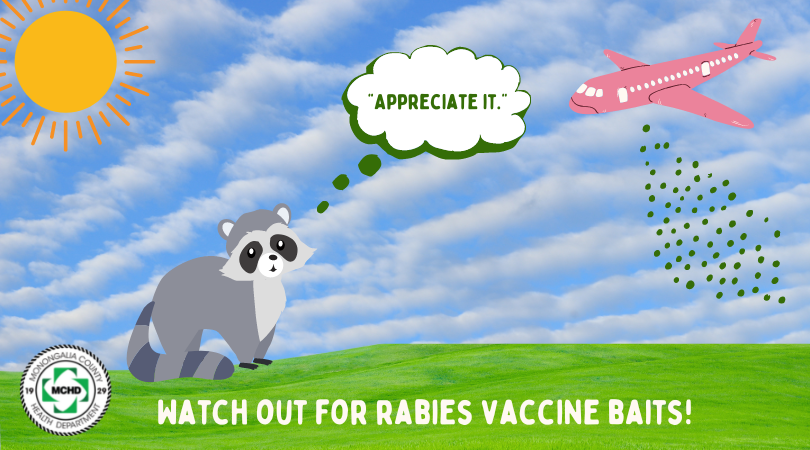Watch out for rabies vaccine baits!

Aug. 10, 2022
By Mary Wade Burnside
Monongalia County residents, especially those with pets that spend time outdoors, should be on the lookout for rabies vaccine baits that will be dropped during August, mostly from aircraft, by the United States Department of Agriculture.
“If you find a bait, leave it where you found it, unless it’s in your lawn or driveway,” said Todd Powroznik, Environmental Health program manager at Monongalia County Health Department. “If you do find any in those places, wear gloves and remove the baits, and put them in a thicker area where raccoons and wild animals will find them.”
The USDA’s Animal and Plant Health Inspection Service (APHIS) conducted its first leg of the bait drops from Aug. 5-8, while the second leg will take place between Aug. 24-31. These oral rabies vaccine (ORV) baits will mostly be dropped from airplanes and helicopters, with some by car 24 West Virginia counties and in several states in the Eastern U.S.
The baits contain rabies vaccine that raccoons and other wildlife consume in order to inoculate them against the fatal virus that can be passed on to other mammals, including humans and their pets, during chance encounters.
Other than the eastern-most tip, Monongalia County is one of the areas slated to receive three types of ORV baits that wrap different vaccines. Two are wrapped in blister packs, one green and one white, and the other is encased in a brown coating. Some contain fishmeal to attract the wildlife, which dogs also might find appetizing. While not toxic or harmful, it’s not a good idea for a dog to ingest many of them.
“Eating a large number might cause an upset stomach in your pet,” Powroznik said.
Dogs, especially those left unattended in a large yard near a field or woods, are especially at risk of encountering these ORV baits and gobbling them up. Owners are encouraged to inspect their yards periodically during August to see if any of the baits have been dropped in their area.
“Just police the area, especially if you have a large yard next to big fields or a wooded area,” Powroznik said.
Luckily, studies have shown that most of the baits reach their intended recipients – raccoons and other wildlife – within four days. “They are all almost gone within a week,” Powroznik said.
Because of bad weather that might crop up and other issues, the USDA releases general dates. The exact date when Monongalia County will be targeted is not known.
Rabies is a viral disease found in mammals that attacks the nervous system, ultimately causing disease in the brain and death, according to the Centers for Disease Control and Prevention (cdc.gov). Once a mammal – including humans – has rabies, it is fatal.
In 2019, Monongalia County experienced about 20 known positive cases of rabies, which was an especially high number. Some of these came from cases in which a dog in a backyard encountered a rabid raccoon. In this situation, if a dog has not been vaccinated for rabies and is bitten or scratched by a rabid animal, euthanasia is the course of action.
"Having these baits in your backyard is preferable to your dog getting into a fight with a raccoon," Powroznik said. "We are asking property owners to be vigilant and inspect their property during this time of year."

In early 2019, Monongalia County Health Department was instrumental in contacting the USDA APHIS office in Elkins and requesting that the airplane drop map, which had gravitated to the west, be moved back east to include more of Monongalia County. The result has been a greatly reduced number of rabies cases.
“In the last few years, we’ve only had a couple of positive specimens for rabies,” Powroznik said. “They keep moving the line back to the east and it’s helping tremendously by vaccinating the wild animals.”
As the USDA airdrop concludes, MCHD Environmental Health Sanitarians will take the next step by distributing more ORV baits in the Morgantown area, in parks, around the rail trail and in other wooded areas.
Last year, sanitarians distributed 1,400 baits in Morgantown on foot and by vehicle. The date for this year should be near the end of August, Powroznik said.
“Once we get notification from the USDA on when our vaccine baits are arriving, we’ll put something out to notify the public that we will be out in marked, slow-moving vehicles, and to keep a watch out for the baits again.”
Mary Wade Burnside is the public information officer at Monongalia County Health Department.